- Submissions

Full Text
Environmental Analysis & Ecology Studies
Birds Effects on Heritage Buildings
Rodríguez Elizalde Rubén*
UOC Open University of Catalonia - Barcelona, Spain
*Corresponding author: Rodríguez Elizalde Rubén, Professor Responsible for Occupational Safety subjects, Occupational Risk Prevention Master’s Degree, UOC Open University of Catalonia - Barcelona, Spain
Submission: September 14, 2022; Published: September 28, 2022

ISSN 2578-0336 Volume10 Issue2
Introduction
This article is based on the need for awareness that should exist today to maintain and reuse existing constructions, and not execute so many new works that would make existing ones obsolete. From this awareness, the need arises to study the mechanisms of deterioration of construction elements: only in this way can a solution be found to the deterioration that many of the elements suffer, particularly heritage elements. This article was written in Spain. Spain is a country with a lot of heritage buildings and cultural value constructions; and Spain is in Europe, a continent with a lot of heritage buildings and cultural value constructions as well. Every building, public or private, can be used by birds. However, cultural heritage buildings pose special problems related to bird damage. So, birds can affect monuments in many ways, causing a lot of alterations: aesthetic alterations, physical and mechanical alterations, chemical alterations or biological alterations.
Thus, one of the degradation factors that currently have more incidence in monuments is the bird nesting and the accumulation of bird droppings. This is especially important in urban areas: there, bird populations increase day by day because of the environment transformations and the environment alterations. Thus, damage and demolition buildings have occurred as a result of bird droppings accumulation. For example, in November 2013, the roof of a primary school collapsed in Mendoza, a city in the western of Argentina, causing various injuries to 17 students [1].
In addition to the unsightly aesthetic effect, bird feces cause chemical damage to the stone substrate [2] and, consequently, its deterioration [3].
On the other hand, when bird droppings are not removed periodically, it can cause the obstruction of rainwater evacuation routes, with the consequences that this entails [4]. Nor should we forget the stability problems that stork nests create both in structural elements and in ornamental elements [5].
Biodeterioration
Once we know the above, it is important to study biodeterioration. The biodeterioration of monuments has been studied from a multidisciplinary perspective, due to the diversity of deterioration processes that it comprises, which are as many as there are agents [6,7].
Within biodeterioration, the agents causing the processes, in principle, are all living beings (including man) and they only have in common that they are born, grow, reproduce and die, and in this vital cycle in which there is a great energy expenditure, build and destroy, of course.
Living beings establish all kinds of relationships with monuments. Food chains are produced in which some depend on others, and in some links of these chains are the birds, of course. For monuments, birds are true scourges, with a destructive potential unthinkable when observed in other environments.
Birds have coexisted with humans in urban and peri-urban environments for as long as such environments exist. In this coexistence, there has been no negative effect for both. However, in the middle of the 20th century, the problems caused by some birds began to increase: their excessive growth began to produce negative impacts, especially on agricultural yields. Later, these impacts were extended, affecting the well-being of the urban population. Thus, was born the need to increase measures to control these birds.
Damage-causing species are all birds whose populations have increased notably thanks to their ability to exploit the resources provided by man, especially food and breeding sites. As we have said before, the impact of birds on human activities was manifested first (and is manifested today fundamentally) in agriculture, as well as in stored products, in the conservation of monuments and buildings, as well as in all kinds of impacts and threats to urban health.
For this reason, an adequate and reconciled coexistence between the avifauna and the human being is currently required. Such coexistence is possible: it only requires the preparation of a control program, in which the Public Administrations, the control operators and, of course, the citizens themselves participate. However, a main objective is pursued, which is to reduce the environmental costs caused by the species that cause damage, maintaining an acceptable density through ecological and human management
This strategy has to be considered in a local context and directed
at the target species [8], taking into account:
A. Ecology. We have to consider population dynamics. Only
an adequate and correct knowledge of the population evolution of a
specific species, in a specific place and over a considerable period of
time, will allow the technician to adopt adequate measures for the
problem to be analyzed.
B. Integration. We have to use several measures
simultaneously. One of the biggest problems that we can face in
bird control is the ability of the species to get used to the elements
that are introduced into their daily habits. Alternating different
practices can avoid this problem.
C. Selection. We have to minimize the impact on “nontarget”
species. It is not understood, at present, to try to act against
a population causing damage, if it cannot be ensured that only the
specimens of the population on which it is intended to act will be
affected.
D. Sustainability. The benefits must outweigh the costs. In
the case of birds, the evaluation of the benefit of control must be
considered in its entirety. In other words, not only the physical
damage against household goods, but also those caused as a
consequence of being animals that carry other vectors (such as
fleas, lice and others) that can cause collateral damage to man.
E. Ethics. The methods must be accepted by public opinion,
in accordance with the law and respecting the welfare of animals.
One of the biggest problems in addressing bird control is citizen
opposition. The capture of birds is not “well seen” by a large
majority of the population [8]. Therefore, the actions have to be
carried out considering all existing legal regulations in this regard.
At all times the welfare of animals must be cared for and protected.
F. Long-lasting effect. Once the poultry control measures
have begun, the actions must be maintained in such a way that
tolerable population levels are maintained. We cannot ignore, at any
time, that we try to deal with animals that have great reproductive
potential. For this reason, the actions must aim to achieve a lasting
effect.
G. However, there is a background that is the claim, also, to
become aware of the importance of investment in maintenance and
conservation of existing buildings. It is time to direct the steps to
a greater extent to take care of, maintain and readapt the already
existing elements, rather than to the execution of new elements, and
it is considered convenient to analyze this factor of deterioration.
Alteration Mechanisms
Birds can affect buildings and monuments in many different ways, causing alterations of all kinds: aesthetic alterations, due, for example, to dirt or the construction of nests of diverse morphology; physical-mechanical alterations, due, for example, to pecking or breakage due to the weight of the nests; chemical alterations, due, for example, to the effects that their excrements produce; or biological alterations, due, for example, to the organic matter they deposit [9], which contributes to the development of a significant microbial flora of a heterotrophic nature, such as bacteria and fun
In global terms, the damage that birds cause in the buildings in which they nest or in the buildings where they alight, including buildings that constitute the artistic and monumental heritage, are increasingly greater [10]. Such effects are highly variable, and can cause blockages in the drainage channels, erosion caused in the stone as a result of droppings or damage caused by the installation of nests in buildings, among others.
When birds alight on roofs, they end up causing leaks and dampness and in some cases even cause bad odors due to the accumulation of droppings in the areas surrounding the air conditioning ducts of buildings [8]. In urban areas it is mainly pigeons that take part in bioalteration processes; while in coastal and river areas they are seagulls [11].
Thus, authors distinguish the destructive action of birds on two
fronts, hence they speak of direct destructive action and indirect
destructive action:
A. The direct destructive action is mechanical (or physicalmechanical)
and chemical. The mechanical action is that exerted
by friction, pecking and other typical poultry actions. This action
is especially damaging on substrates that have poor adhesion. The
chemical action, on the other hand, is caused by excrements rich in
organic nitrogen and phosphates, mainly in the form of uric acid,
phosphoric acid and nitric acid.
B. The indirect destructive action is the action that is carried
out by the contribution of organic substances that serve as nutrients
to the aforementioned heterotrophic microflora (bacteria, fungi).
Autotrophic flora can also benefit from the presence of these substances.
Similarly, the performance of these organisms as vectors in the propagation of other species must be taken into account. Their reproductive structures can remain attached to their feathers or legs and, in this way, be transported on the stony substrate; or as controls of the populations of other living beings on which they feed. Some birds, such as pigeons [12] or storks [13], in their original habitats nested in rocks or vertical areas; however, in the urban environment they have found substitute resources according to their needs.
In this sense, when the human being introduced the buildings in their habitat, the pigeons immediately adapted to this new favorable environment, all of this enhanced by the breeding of pigeons for food purposes. What was initially tolerable and even promoted in that environment and historical context, ended up being a problem in the city when man stopped using pigeons for economic or food purposes and these, in turn, became urban.
These circumstances largely explain the problematic interaction between urban pigeons and man, as well as the risks associated with such birds. And it is that at present the pigeons use any space or cavity available in a construction, especially if it is located near a food source, to form their nests or take refuge, causing damage, both structural and aesthetic.
Not limiting itself to pigeons exclusively, but expanding the range of pernicious birds, the causes of such damage could be explained based on their nature. Without forgetting that the dividing line between one and the other is not rigid or static, but rather that all areas are interrelated, the areas or families of natures of damage that make up the following sections are distinguished [10,14].
Physical-Mechanical Alteration
Damage of a physical-mechanical nature derives mainly from the vital action of birds for the construction of nests and from their nature.
For example, barn owls make their nests in very large holes (Figure 1) and usually very deep in steeples, vaults, and even pinnacles. They not only make them outside, but also inside buildings, taking advantage of elements such as sculptures.
Figure 1: Owl half-hidden in the hollow of a wall of an old building in Mieres, Asturias (Spain). Author’s photograph.
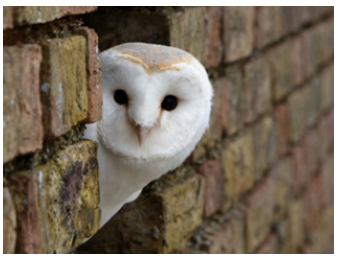
Storks, on the other hand, prefer bell towers [5], although we can find it on the roofs of buildings (Figure 2).
Figure 2: Storks nest on the roof lantern of the Ermita de Santa Lucía, in Alcalá de Henares (Spain). Author’s photograph..

In addition, a lot of birds file their beaks over construction element and ingest small fragments of stone material to promote their digestion. These small fragments of stone material are plucked from the monuments by them. In the case of the storks, for example, they fundamentally remove stone from the sculptures, and more specifically from the area of the face or shoulders, since they are the most prominent points; pigeons, for their part, tend to peck at materials that are not very resistant, such as the plastering of facades or the external protection of pipes, in order to cover the mineral contributions that their diet lacks and to get abrasives for food in their gizzard.
As we already pointed out at a general level, within the action
of a physical-chemical nature, direct and indirect actions should be
distinguished [10]:
A. The direct action would be, for example, the action
produced on the structures by the adults and the chicks of the
different species. We include here the already mentioned direct
pecking on the facades, or the elements of the walls, to obtain the
material that helps their digestive process.
B. The indirect action, on the other hand, is due to the weight
of the material accumulated in the nests. Among such material
would be excreta, branches and other elements. It is not convenient
to minimize such damage depending on the species: although it
is conceivable that in the case of some birds, such as pigeons, this
weight is less than in the case of others, such as storks, seagulls or
parrots, it can become significant in the case of very old nests or in
special circumstances. This would be the case, for example, of the
collapse of false ceilings and air chambers below deck.
The following cases would also be included within the indirect
action:
A. The damage caused by the growth, on the facades, of
plant roots that have germinated on the nests. The reason for this
consideration is that the plant comes from the seeds that the birds
brought to the nests or that they eliminate, through their faeces, in
the same location.
B. The inherent effect of the water that penetrates through
the cracks and crevices produced by the action of birds and that,
when it freezes in winter (the freeze-thaw cycle), expands and
deteriorates the materials considerably.
C. The damage associated with the periodic cleaning tasks
of the facades, which are essential to tidy up such walls and other
spaces smeared by nests and excrement. Also take into account the
cost of these operations.
D. Direct or indirect mechanical damage associated with the
installation of specific protection elements against poultry action;
that is, the damage caused by any of the technical solutions to
protect the construction elements.
Chemical Alteration
Chemical nature damage has been perhaps the most highlighted and studied by the experts in heritage protection. The chemical alterations that birds produce are related, above all, to the chemical nature of the excrements of some of the bird species, fundamentally pigeons and seabirds. Those of pigeons are known by the generic name of palomina and those of seabirds as guano, exactly the same as in the case of bats. Guano is exploited as a natural fertilizer [15].
The droppings of such species are mainly composed of ammonia (NH3), uric acid (C5H4N4O3), phosphoric acid (H3PO4), oxalic acid (H2C2O4) and salts [14]. It is yellowish in color and, although it has been said that it is used as a fertilizer, it has tremendously corrosive effects on monuments (Figure 3).
Palomina, which can also be used as a fertilizer under certain conditions, is a real scourge in the conservation of monuments, due to its chemical composition, mainly with the aforementioned uric and phosphoric acids. The chemical action is manifested here in the reaction that occurs between the components of the urine - excrement of the pigeons with the stone and that can lead, depending on its composition, in a more or less accelerated way to its progressive dissolution.
In addition, the droppings of some species cause premature corrosion and oxidation of some metal structures and other similar elements (Figure 3), damage the paint of vehicles, without forgetting the unsightly effect that the stain of the depositions causes on the surface on which excrement falls (Figure 4, 5 & 6), whether they are buildings, vehicles, statues, benches or any other monument or element of urban furniture.
Figure 3: Monument to the Turia River in the Plaça de la Verge in Valencia, next to the Cathedral. Here we can observe the presence of pigeons, as well as the defecated pigeon on sculptural elements.
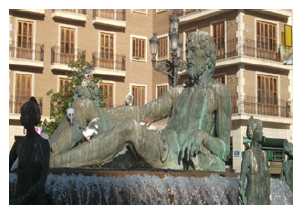
Figure 4:Remains of excrement, under a stork’s nest built on the roof of the banstand in the Plaza de Cervantes in Alcalá de Henares (Spain).
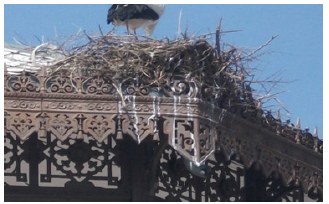
Figure 5:Pigeon feces accumulation of at the base of a corinthian column, in the colonnade of the Iglesia de Santa María, in Alcalá de Henares (Spain).
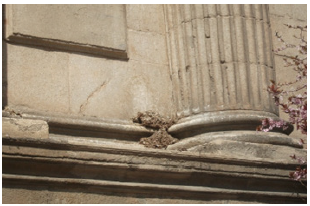
Figure 6:Swallow droppings accumulation over installation elements on the of a residential building facade in Toledo (Spain).
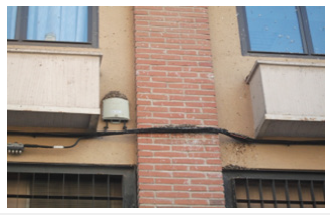
Without particularizing bird species, we can affirm that poultry droppings incorporate ammonia, uric, phosphoric, oxalic acid and salts into the factories. In this way, if the masonry is made of stone rich in calcium carbonates (such as limestone, for example), we can infer that adding acid to them will activate the carbonation cycle, according to

Thus the rock breaks down to produce calcium bicarbonate, which is soluble in water. The same can be deduced for those cases in which it is a cement construction element.
Uric acid is a heterocyclic organic compound, consisting of carbon, nitrogen, oxygen, and hydrogen, with the chemical formula C5H4N4O3sub> (Figure 7). It is the main waste product of birds, and is expelled with the feces; animals that predominantly excrete uric acid are called uricotelic [16]. The high nitrogen content of uric acid is the reason why guano is so valuable as a fertilizer in agriculture.
Figure 7: Chemical structure of uric acid. Image by Vasiliu & Buruiana [25].

Uric acid, at an alkaline pH, undergoes an oxidation process in the presence of catalytic amounts of copper, such as can be incorporated in any bronze monument (Figure 3). The initial product of oxidation is similar to dehydroascorbic acid (or cystine), called dehydrouric acid.
Phosphoric (or orthophosphoric) acid, on the other hand, is a ternary compound, whose formula is H3PO4; it belongs to the category of oxoacids (Figure 8).
Figure 8: Chemical structure of phosphoric acid.
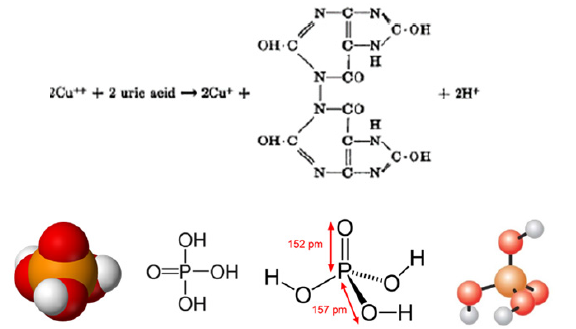
Biological Nature
Although all the alterations produced by birds on the monumental heritage are important and must be considered, the alterations of a biological nature constitute one of the most worrying. They allow, directly or indirectly, the development of a very extensive microbial flora, which not only causes chemical alterations; so much so, that some of the species that develop are carriers of diseases even for humans. Some of the manuals consulted for this article jointly address the chemical and biological nature [17].
The presence of organic matter, due to the metabolites they produce and the other organic remains that accumulate, such as droppings, feathers or remains of corpses, among others, allow the development of an important heterotrophic microbial flora, both bacterial and fungal, which contributes and favors the chemical attack of stone and metallic elements [6,7].
In addition, at the mercy of other substances, which are provided by said dejections, microorganisms of the nitrogen and sulfur cycles develop that present a synergistic action leading to nitrification and the formation of acids even more corrosive than those already mentioned, such as sulfuric acid or nitric acid [6].
Let us also frame this in the fact that the technicians who are in charge of the construction, conservation, maintenance and rehabilitation operations of constructions have little knowledge in biological matters. We cannot forget, in this sense, that guano or palomina, as fertilizers, are very effective fertilizers, thanks to their high content of three main components for the growth and development of plants: nitrogen, phosphorus and potassium.
Seabird guano is rich in nitrogen, ammonium oxalate ((NH4)2C2O4sub>.H2O), urea, phosphorus and phosphates, and earth salt and impurities as well as; pigeon manure is also a highly coveted fertilizer thanks to its properties to fertilize plants and soils. For all these reasons, the excrement can be a fertilizer that favors, indirectly and together with other factors, the growth of plants and vegetation on the constitutive rock of the facing ashlars and other construction elements (Figure 8) [7].
Thus, the biological action is associated with the proliferation of parasites or microorganisms, whose growth is encouraged by the excrement deposits, rich in nitrogen or by the humidity associated with previously induced mechanical damage (or even by a combination of both) . These microorganisms can generate, in turn, different types of excretions and substances, capable of behaving as aggressive agents for construction materials [6].
Wooden structures can also be damaged by the development and growth of fungi [7], which are present in the droppings.
Collateral Damage
Along with the aforementioned mechanisms, there are other collateral effects that derive, of course, from the biological activity of the birds, from the types of alterations that the birds produce, as well as from the methods that exist to eliminate these alterations.
The aesthetic and physical damage that birds cause is primarily the patinas of dirt that, sometimes, end up becoming authentic accumulations of droppings, food scraps, broken eggs, nests or carcasses.
In the case of nests, the effects can be even more important depending on the weight and the materials with which they have been erected. Some nests, such as those of storks that are built with branches that accumulate year after year, have come to destroy bell towers and roofs of monuments. As an example, we can cite the case of the church of Rágama, near to Salamanca (in Spain), where a side roof collapsed due to the fall of a stork’s nest in 2009 [18]. The case of the parish church of Andosilla, in Navarra (Spain) can also be cited: there a nest of storks nesting in the tower fell on a vault, causing it to collapse [19].
Other nests are made with mud and some corvids that live in cities, such as magpies, which use any waste material from man, such as aluminum foil or plastic bags.
We have already said before that the nests can obstruct the drains, which in a building constitutes a real danger due to the increase in humidity, which, as is well known, is one of the worst pathologies that a monument can suffer [14] (Figure 9 & 10). In addition, the chemical and biological alterations that they produce lead to a sometimes very severe change in the chemical composition of the support, making its repair impossible in some cases and conditioning restoration techniques [6].
Figure 9: Seagull on the roof lantern that tops one of the three domes with metallic gloss chevrons of the Municipal Palace of a Coruña, current seat of the City Council. We can see, next to the place where the bird has perched, the presence of vegetation.
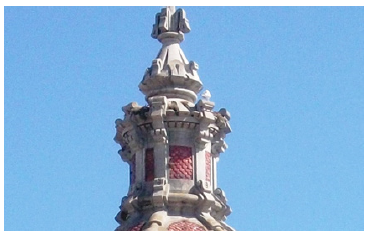
Figure 10: Detail of the roof of a residential building. The presence of birds can lead to the accumulation of a large amount of droppings and feathers, in addition to the birds that die on the roofs, which can clog drains and gutters, causing leaks and other damage.

The measures adopted to eliminate or repel birds from monuments [20] also constitute, in themselves, a problem due to their conservation, their design and their permanence over time, since they are difficult to maintain. Such would be the case, for example, of the placement of structures to contain the nests on the monument itself or the installation of cables to scare away the pigeons.
Finally, and although it does not directly affect monuments but it does affect people, we must not forget that birds are a problem from a health point of view due to the various parasites they carry. These can transmit diseases to man and the microorganisms that develop as a result of their activity can be pathogenic. As an example, there are the following types caused by bacteria and fungi: Clamidiosis, Salmonelosis, Colibacilosis, Histoplasmosis and Alveolitis Alérgica. All of them can cause a wide range of diseases, in a wide range of hosts, including humans, other mammals and, of course, birds [7].
In unprotected buildings and facilities, certain birds are capable of causing significant damage; damages that, in turn, are the cause of non-negligible economic losses and conflict between citizens. This is the case, for example, of those who feed the birds, compared to those who suffer the consequences of poultry activity on their properties.
To a great extent, the damage referred to in the previous
paragraph is a direct consequence of the habit of some birds of
nesting in constructions. Such damages include, among others, the
following:
A. Humidity due to damage to roofs, roof drains, gutters and/or
downspouts.
B. Dirt/damage to awnings.
C. Dirt / damage to hanging clothes.
D. Expenses associated with facade cleaning interventions.
E. Damage to plantations and gardening.
F. Costs associated with operations to protect buildings, patios,
or the like against birds.
Hygiene
The main hygienic risk is linked to faeces. If faeces become wet, such as after rain, they become slippery, posing a risk to pedestrians and, depending on quantity and location, cyclists and motorists. The nests, it is insisted, can reach considerable sizes, even exceed one hundred kilograms, with danger for passers-by in the event of their fall.
Some large species become aggressive during the nesting season, even reaching, as in the case of some gulls [21], to attack humans if they feel threatened. The accumulation of excrement is the breeding ground for many potentially harmful microorganisms. Special vigilance deserves the so-called invading microorganisms, coming from other places, such as avian influenza [7].
In the plumage of birds, as well as in their nests, arthropods are housed [7] with a possible impact on human health and that of other species. The presence of pigeon ticks (argas reflexus) [1] has been confirmed in dwellings of buildings where they have nested [24].
Finally, feathers and droppings can contaminate drinking water reservoirs and stored food [10].
Cosmetic Damage
As has already been pointed out in the previous sections, the accumulation of excrement, feathers, nests, eggs and even some carcasses of the birds themselves, create a series of layers of dirt on the monuments that, in the case of the excrement, destroy the aesthetics of it. Anyone will have in mind the case of Venice’s Piazza San Marco [22], perhaps because it is one of the best known worldwide, but unfortunately it is not the only one.
Throughout the trips made to prepare this article, we were able to discover these alterations throughout the geography in monuments located both in large cities and in towns, and even in the middle of nature. The effect of bird movements on the roofs of buildings is an especially harmful aspect in the case of heavy birds, such as seagulls or storks; the scratches of their claws and their pecks, are also an agent of deterioration in the walls and walls.
The construction of nests on the roofs or their installation in their air chambers cause the breakage of tiles and the fall of other elements. When they are large, as in the case of storks, fractures of great magnitude can be caused [23].
The accumulation of faeces stimulates the corrosion and degradation of many construction materials, both metallic and stone; For this reason, in the long run, a deterioration in facades, structural and ornamental elements, urban furniture and vehicles originates [11]. Likewise, some highly corrosive excrements also destroy plants and trees in gardens, and their corrosive action may also accelerate the aging of different types of machinery
The accumulation of debris from its activity produces the obstruction and breakage of gutters and downspouts, generating leaks and humidity in the buildings which, in turn, promote the aforementioned colonization of microorganisms that further increase their deterioration.
Economic damages
Firstly, we must take into account the damage caused by the aforementioned health impact: the presence of birds increases the maintenance and conservation costs of buildings and public spaces. Population monitoring and control campaigns constitute a budget to be added to the previous chapters.
Other impacts
The activity of some species can generate annoying noises and bad smells; in this sense, it is worth highlighting the impact it produces in tourist areas [10]. The proliferation of exotic species, if they take advantage of the same resources, nesting place, food, and others, can cause the displacement of the native fauna. Some flocks of birds can cause interference to air traffic [10]
Certain birds, mainly starlings and sparrows due to their type of feeding, are considered harmful in gardens and in some crop areas [10]. Special mention deserves, once again, the droppings of the birds. It is recalled again that such faeces contain, or can lead to, acids such as uric, phosphoric or nitric, as well as enzymes, mineral salts and water in different proportions. The acidity of the droppings makes them an extremely corrosive substance, so that, over time, they affect different structures, causing problems of an aesthetic nature, and others of a hygienic nature. Depending on their degree of humidity, such droppings can be transformed into humus, which can serve as a settlement for different botanical species that complete the biodeterioration action [11], entering and increasing the size of possible cracks in the stone substrate [17], reaching crumble items such as tiles and bricks.
The set of all these pernicious aspects has caused the need to census and control the populations of certain species [23], which is implying certain controversies because, apart from certain prejudices and cultural considerations about birds (or certain species of birds), inadequate control can have very negative effects, not only on the target species but also on others that are in some way detrimental.
References
- Bugle (2022) Part of the roof of a school fell: 17 students injured.
- Alonso Rodríguez FJ, Esbert Alemany RM, Ordaz Gargallo J, Vázquez Menéndez P (2006) Analysis of the deterioration of stone building materials.
- Charola AE, Ware R (2002) Acid deposition and the deterioration of stone: A brief review of a broad topic. Geological society, Special Publications, London 205(1): 393-406.
- Fort González R (2007) Atmospheric pollution in the deterioration of monumental heritage: Prevention measures.
- Ortega RG, Rodrigo NV (1997) The white stork and the Architectural Heritage. PH: Bulletin of the Andalusian Institute of Historical Heritage 5(18): 26-32.
- Caneva G, Nugari MP, Salvadori O (2000) Biology in restoration, p. 5.
- Valgañón V (2008) Biology applied to conservation and restoration.
- Jiménez Peydró R (2009) Approach and solutions to the problems caused by birds in the Spanish heritage. Bueso M (Ed), Incidence of Birds in the Conservation of Monuments. Institute of Cultural Heritage of Spain IPE - Ministry of Culture.
- Ruiz VH (2004) Pigeons, harmful to monuments and public health.
- VVAA (2013) Guide to good practices for the management of urban bird pests. National Association of Pest Control Companies ANECPLA.
- Murillo SG, Pérez AM (1996) Living organisms as factors that actively contribute to the deterioration of our monuments. PH: Bulletin of the Andalusian Institute of Historical Heritage 4(14): 57-66.
- Ortizo R, Ortiz P (2016) Vulnerability index: A new approach for preventive conservation of monuments. International Journal of Architectural Heritage 10(8): 1078-1100.
- Maricato L, Faria R, Madeira V, Carreira P, de Almeida AT (2016) White stork risk mitigation in high voltage electric distribution networks. Ecological Engineering 91: 212-220.
- Arroyo I (2009) Approach to the problem of birds on monuments. Collateral damage. Bueso M (Ed), Incidence of Birds in the Conservation of Monuments. Institute of Cultural Heritage of Spain IPE - Ministry of Culture.
- Clark B, Foster JB (2013) Guano: The global metabolic rift and the fertilizer trade. In Ecology and power, Routledge, USA, pp. 84-98.
- Fernandes JIM, Murakami AE (2010) Arginine metabolism in uricotelic species. Acta Scientiarum Animal Sciences 32(4): 357-366.
- García de Miguel JM (2009) Treatment and conservation of stone, brick and mortar: in monuments and constructions. General Council of Technical Architecture of Spain, Spain.
- 20minutos (2009) The roof of a church collapses after a stork's nest falls due to the wind.
- Noticias de Navarra (2014) The Government will pay for the damage to a stork nest in Andosilla.
- Cirujano C (2009) Anti-bird systems: aesthetics, effectiveness and maintenance. Bueso M (Ed), Incidence of Birds in the Conservation of Monuments. Institute of Cultural Heritage of Spain IPE - Ministerio de Cultura.
- Zaragozí AY, Gomis E (2004) The birds that live in the castles of Alicante.
- Jerolmack C (2013) The global pigeon. In The Global Pigeon. University of Chicago Press, USA.
- Vázquez A, urban birds; its heritage problem. Bueso M (Ed), Incidence of Birds in the Conservation of Monuments. Institute of Cultural Heritage of Spain IPE - Ministry of Culture.
- de Vicente Rivas M, Fernández AR, Sanz VER (2011) Bacteriological weapons. REDUCA, Las palomas, USA, 3(3):
- Vasiliu A, Buruiana D (2010) Are birds a menace to outdoor monuments? In International Journal of Conservation Science 1(2): 83-92.
© 2022 © Rodríguez Elizalde Rubén. This is an open access article distributed under the terms of the Creative Commons Attribution License , which permits unrestricted use, distribution, and build upon your work non-commercially.
 a Creative Commons Attribution 4.0 International License. Based on a work at www.crimsonpublishers.com.
Best viewed in
a Creative Commons Attribution 4.0 International License. Based on a work at www.crimsonpublishers.com.
Best viewed in 







.jpg)






























 Editorial Board Registrations
Editorial Board Registrations Submit your Article
Submit your Article Refer a Friend
Refer a Friend Advertise With Us
Advertise With Us
.jpg)






.jpg)














.bmp)
.jpg)
.png)
.jpg)










.jpg)






.png)

.png)



.png)






